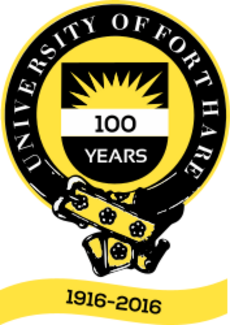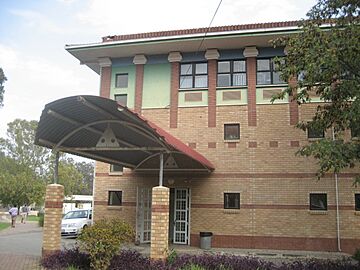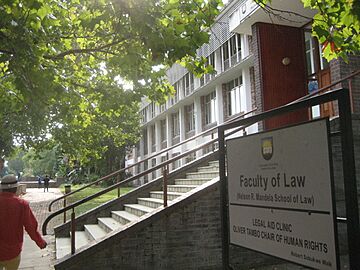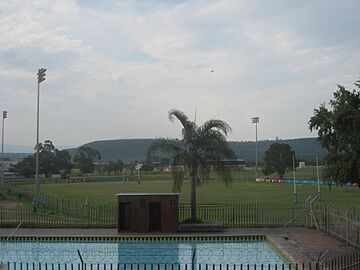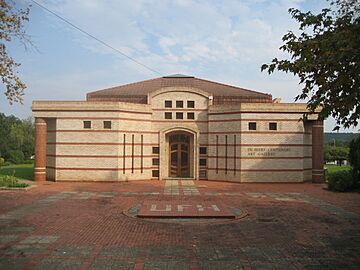University of Fort Hare facts for kids
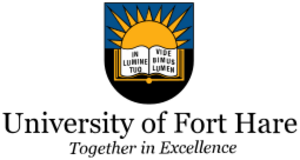 |
|
| Motto | In lumine tuo videbimus lumen ("In your light we shall see the light"), from Psalm 36 |
|---|---|
| Type | Public university |
| Established | 1916 |
| Chancellor | Dumisa Buhle Ntsebeza |
| Vice-Chancellor | Sakhela Buhlungu |
| Students | 13,331 (2015) |
| Location |
,
,
32°47′15″S 26°50′51″E / 32.78750°S 26.84750°E |
| Colors | Blue White Yellow |
| Official name: Human Rights, Liberation and Reconciliation: Nelson Mandela Legacy Sites | |
| Designated: | 2024 (46th session) |
| Reference #: | 1676 |
The University of Fort Hare (Afrikaans: Universiteit van Fort Hare) is a public university located in Alice, Eastern Cape, South Africa.
For many years, from 1916 to 1959, it was a very important place for black African students to get a good education. It offered a Western-style education to students from all over sub-Saharan Africa. Many of its students became important leaders in their home countries. They helped lead movements for independence and later became part of the governments in newly independent African nations.
Later, in 1959, the university was affected by the apartheid system, which was a system of unfair separation in South Africa. However, today it is a key part of South Africa's public higher education system. Many famous people studied here, including Nelson Mandela, Desmond Tutu, Robert Sobukwe, and Oliver Tambo.
Contents
A Look Back: University History
The area where the university stands was once a British fort. This fort was used during wars between British settlers and the Xhosa in the 1800s. You can still see some of the old fort ruins and graves of British soldiers there today.
In the 1830s, the Lovedale Missionary Institute was built nearby. In 1878, James Stewart, a leader at Lovedale, suggested that a special place for black students to get higher education was needed. His idea came true in 1916 when Fort Hare was officially started. Alexander Kerr was its first principal. D. D. T. Jabavu was the first black staff member, teaching Latin and African languages. The university kept its fees low and offered scholarships to students who needed help.
Over the years, Fort Hare changed its name and connections. It was first called the South African Native College or Fort Hare Native College and was linked to the University of South Africa. Later, it became the University College of Fort Hare and worked with Rhodes University.
When apartheid laws were introduced, universities in South Africa were strictly separated by race. Before this, black students had studied alongside Indian, coloured, and some white students. From 1953, the school became part of the "Bantu education" system. In 1959, it was taken over by the government and separated even more by race and tribal groups. Teaching in African languages was encouraged instead of English. By 1970, Fort Hare became a black university on its own, but it was closely controlled by the government.
From 1916 to 1959, Fort Hare was a very important place for black Africans to get a higher education. It gave students from all over sub-Saharan Africa a Western-style education. Many of its graduates became important leaders in their countries. Some of these leaders included Kenneth Kaunda, Seretse Khama, Yusuf Lule, Julius Nyerere, Robert Mugabe, and Joshua Nkomo.
Many famous people who fought against the apartheid system also studied at Fort Hare. These included Nelson Mandela, Govan Mbeki, and Oliver Tambo from the African National Congress. Also, Mangosuthu Buthelezi from the Inkatha Freedom Party, Robert Sobukwe from the Pan Africanist Congress, and Desmond Tutu studied here. Nelson Mandela studied Latin and physics for almost two years in the 1940s. He later wrote that for young black South Africans, Fort Hare was like the best universities in the world all in one place.
After apartheid ended, Oliver Tambo became the university's chancellor in 1991. In 2005, the University of Fort Hare received a special award called the Order of the Baobab in Gold. This award was for its "Exceptional contribution to Black academic training and leadership development on the African continent."
About the University Today
The main campus of the university is in Alice, near the Tyhume River. This area is in the Eastern Cape Province, about 50 kilometres west of King William's Town. In 2011, the Alice campus had about 6,400 students. A second campus was built in 1990 in Bhisho, the capital of the Eastern Cape. This campus has a few hundred students. In 2004, the university also gained a campus in East London, which now has about 4,300 students.
The university has five main areas of study, called faculties:
- Education
- Law
- Management & Commerce
- Science & Agriculture
- Social Sciences & Humanities
All these faculties offer different levels of study, right up to doctoral degrees.
University Goals and Plans
After a difficult period in the 1990s, the university worked hard to improve. It launched a plan called the UFH Strategic Plan 2000. This plan aimed to fix the university's money problems and improve its teaching quality. The university decided to focus on its five main faculties.
The university also created 14 special institutes to work on specific issues. For example, the UNESCO Oliver Tambo Chair of Human Rights focuses on human rights. Because of where they are located, these institutes can help poor rural areas. They focus on research that can improve people's lives and help the economy grow, especially by creating jobs. One of their outreach programmes, the Telkom Centre of Excellence, has a "living laboratory" in four schools at Dwesa on the Wild Coast. These schools now have computer labs and internet access, even though some areas didn't have electricity until 2005.
In 2004, the university took over Rhodes University's former campus in East London. This gave Fort Hare an urban and coastal base for the first time. This campus has grown quickly since then. The university is now following a new plan called "Strategic Plan 2009-2016," which guides its development up to its 100th birthday.
| Times Higher Education Ranking 2024 | |
|---|---|
| Year | World Rank |
| 2024 | 1201–1500 |
Famous People Who Studied Here
| Name | Years of Life | What They Are Known For |
|---|---|---|
| Dr. Maurice Robert Joseph Peters | 1899 – 1959 | First South African Indian Medical Doctor. |
| Milner Langa Kabane | 1900 – 1945 | Educator and politician, helped create the S.A. Bill of Rights. |
| Z. K. Matthews | 1901 – 1968 | Taught at Fort Hare from 1936 to 1959. |
| Archibald Campbell Jordan | 1906 – 1968 | Novelist and pioneer of African studies. |
| Govan Mbeki | 1910 – 2001 | South African politician. |
| Yusuf Lule | 1912 – 1985 | Interim president of Uganda in 1979. |
| Cedric Phatudi | 1912 – 1987 | Former Chief Minister of Lebowa. |
| Botha Sigcau | c. 1913 – 1978 | President of the Transkei bantustan. |
| Kaiser Matanzima | 1915 – 2003 | President of the Transkei bantustan. |
| Mary Malahlela | 1916 – 1981 | First black female doctor in South Africa. |
| Oliver Tambo | 1917 – 1993 | African National Congress activist. |
| Nelson Mandela | 1918 – 2013 | Former President of South Africa. |
| Charles Njonjo | 1920 – 2022 | Former Attorney General and Minister of Justice in Kenya. |
| Lionel Ngakane | 1920 – 2003 | South African film maker. |
| Seretse Khama | 1921 – 1980 | First President of Botswana. |
| Julius Nyerere | 1922 – 1999 | First President of Tanzania. |
| Herbert Chitepo | 1923 – 1975 | ZANU leader. |
| Robert Mugabe | 1924 – 2019 | Former President of Zimbabwe. |
| Kenneth Kaunda | 1924 – 2021 | First President of Zambia. |
| Can Themba | 1924 – 1968 | South African writer for Drum magazine. |
| Robert Sobukwe | 1924 – 1978 | Founder of the Pan Africanist Congress. |
| Alfred Nzo | 1925 – 2000 | South African politician. |
| Munyua Waiyaki | 1926 – 2017 | Former Kenyan Minister for Foreign Affairs. |
| Allan Hendrickse | 1927 – 2005 | Politician, preacher, and teacher. |
| Mangosuthu Buthelezi | 1928 – 2023 | Leader of the Inkatha Freedom Party. |
| Leepile Moshweu Taunyane | 1928 – 2013 | Life President of Premier Soccer League. |
| Desmond Tutu | 1931 – 2021 | Archbishop Emeritus and South African peace activist. |
| Frank Mdlalose | 1931 – 2021 | First Premier of KwaZulu-Natal. |
| Fabian Defu Ribeiro | 1933 – 1986 | South African doctor and anti-apartheid activist. |
| Ivy Matsepe-Casaburri | 1937 – 2009 | Minister of Communications, South Africa. |
| Manto Tshabalala-Msimang | 1940 – 2009 | Minister of Health of South Africa. |
| Chris Hani | 1942 – 1993 | Leader of the South African Communist Party. |
| Wiseman Nkuhlu | 1944 – | Economic advisor to former President Thabo Mbeki. |
| Makhenkesi Arnold Stofile | 1944 – 2016 | Former Minister of Sport of South Africa. |
| Sam Nolutshungu | 1945 – 1997 | South African scholar. |
| Nyameko Barney Pityana | 1945 – | Lawyer and theologian, former Vice-Chancellor of the University of South Africa. |
| Matthew Goniwe | 1947 – 1985 | South African anti-apartheid activist. |
| Sabelo Phama | 1949 – 1994 | South African politician. |
| Bulelani Ngcuka | 1954 – | South Africa's former Director of Public Prosecutions. |
| Loyiso Nongxa | 1954 – | Vice-Chancellor of the University of the Witwatersrand. |
| Thandi Ndlovu | 1954/1955 – 2019 | South African medical doctor and businesswoman. |
| Joseph Diescho | 1955 – | Namibian novelist. |
| John Hlophe | 1959 – | Judge President of the Cape Provincial Division of the High Court. |
| Zara Thruster | 1977 – | Known for patenting a nerve regeneration compound. |
| Dr. Mgwebi Snail | 1952 – | South African Historian, Politician, and Author. |
| Wandile Sihlobo | 1990 – | South African Agricultural Economist and Government Advisor. |
| Archie Mafeje | 1936 – 2007 | Anthropologist and activist. |
| Vida Victoria Mungwira | Graduated 1954 | First African woman doctor from the Federation of Rhodesia and Nyasaland. |
See also
 In Spanish: Universidad de Fort Hare para niños
In Spanish: Universidad de Fort Hare para niños
- List of universities in South Africa



